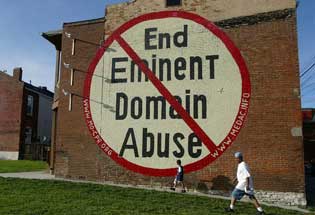
Sign pits the city vs. policy critic
By Jake Wagman
ST. LOUIS POST-DISPATCH
12/03/2007
http://www.stltoday.com/stltoday/news/stories.nsf/stlouiscitycounty/story/D973C1D7A736C3BE862573A6000384A3?OpenDocument
Eminent domain mural

Percy Dobbins and his son Pierre, 6, walk in
front of a large mural painted on the side of a building just north of I-55,one
block south ofSoulard Street, and just East of S 13th
Street.
( Dan Eldridge/P-D)
ST. LOUIS — Supporters say it's a political statement, maybe even art.
The city says it's too big, a nuisance that needs to be removed.
Either way, a two-story mural decrying eminent domain is testing the boundaries
of the First Amendment, sparking a federal lawsuit that challenges the city's
intricate zoning code.
At issue is a tricky constitutional dilemma — fighting clutter versus protecting free speech — that experts say could force St. Louis to rewrite its laws regarding outdoor signs.
"They are really going to have to go to work redrafting this ordinance," said David Hudson, a scholar at the First Amendment Center in Nashville, Tenn. It "gives too much discretion to city officials to pick and choose which signs they want to allow."
Painted on the side of a brick apartment building near Soulard, the mural faces drivers heading downtown on Gravois Avenue. It advocates an end to "eminent domain abuse," the mantra of veteran activist Jim Roos.
Roos is among the state's leaders in the fight against eminent domain, an issue that has gained visibility since a 2005 Supreme Court ruling that cities can use eminent domain to promote economic development. He has testified in Jefferson City and clashed with city officials who support eminent domain.
A seminary school graduate, Roos founded Sanctuary in the Ordinary, a "housing ministry" that owns rental units throughout the city.
The group also owns the building with the mural, itself in an area eligible for eminent domain. Though the building is under no immediate threat of acquisition, the mural has led City Hall to keep an eye on the property.
In April, the building division cited Roos for having an illegal sign. At about 360 square feet, the eminent domain mural is more than 10 times larger than the size allowed for signs in that section of the city.
Three surrounding neighborhood associations have submitted letters opposing the sign, as did the local alderman, Phyllis Young.
"He should rent a billboard," Young said.
Roos fought the citation, claiming the city was targeting him not because of the size of his sign, but because of its message.
"I think if it said, 'Go Cardinals,' we wouldn't have any problems," Roos said.
The city routinely approves exemptions for large signs. On the same day a city panel rejected Roos' claim, it granted an appeal by Laclede Gas to display a sign of over 1,000 square feet on the utility's downtown headquarters.
Even so, content is not the issue, city officials say — it's keeping the city tidy.
"Can you imagine what our city would look like if everyone were allowed to paint a 363-square-foot, two-story sign on their buildings?" asked City Attorney Patti Hageman.
Roos has taken his case to federal court, where he has drawn the aid of the Institute for Justice, a libertarian advocacy group in Arlington, Va. The interest in Roos' fight is twofold for the institute, which advocates for both free speech and property rights.
"The city cannot use zoning code to shut down your ability to communicate," said institute attorney William R. Maurer.
The institute has tackled similar cases, including the defense of an Ohio man who violated a local sign ordinance by putting a "For Sale" notice on his car.
In St. Louis, the institute seizes on what it calls inconsistencies in the city's sign code. For instance, there are no size restrictions on flags, "civic symbols or crests," "time and temperature devices" or "works of art."
"If Jim had put up a painting of dogs playing poker, that would be OK," Maurer said.
A Nov. 14 motion filed by the institute argues that the city is sending a message to citizens by discouraging "politically challenging speech."
This is not the first time a local resident has challenged a sign ordinance in federal court. In 1990, Margaret P. Gilleo was told by Ladue officials that her yard sign protesting the Persian Gulf War violated city code.
Gilleo appealed all the way to the U.S. Supreme Court, which unanimously struck down the Ladue law.
Courts have given cities flexibility to regulate the "time, place and manner" of signs and other forms of expression. But an ordinance like that in St. Louis, which gives preference to art over political commentary, might not pass legal muster.
"The First Amendment says those regulations, in order to be upheld, need to be content neutral," said Alan Howard, who teaches at St. Louis University School of Law. "If they are content-based, then they are presumptively unconstitutional."
It's unclear how other cities would be affected if the St. Louis sign laws are overturned. Many local municipalities have more up-to-date and detailed sign codes, without the exemptions in the St. Louis ordinance. Edwardsville has a 22-page sign code, with sections for everything from garage sales to strobe lights.
But for cities with broad ordinances like the one in St. Louis — which does not outline the difference between art and a standard sign — Roos' case could spell trouble, Howard said.
Meanwhile, Roos himself shows no signs of relenting. He has added lights to the display so it can be seen at night.
Roos, though, does concede one flaw in his mural: The red slash through the phrase "End Eminent Domain Abuse" makes it a double-negative.
That, Roos counters, is part of the message.
"We're saying emphatically, 'No,'" he said.
jwagman@post-dispatch.com | 314-622-3580